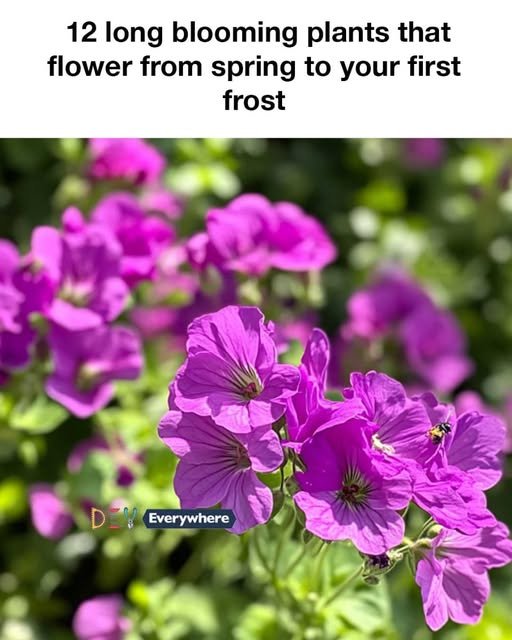Long blooming plants are a gardener’s dream, providing continuous color and vibrancy from spring until the first frost. These plants are not only beautiful but also versatile, fitting into various garden styles and climates. They offer a seamless transition through the seasons, ensuring that your garden remains lively and engaging for months on end. Whether you’re an experienced gardener or a novice, incorporating long blooming plants can transform your outdoor space into a lush, colorful haven.
Understanding the Importance of Long Blooming Plants
Long blooming plants are essential for maintaining continuous interest in your garden. They provide a consistent source of nectar and pollen for pollinators like bees and butterflies, supporting local ecosystems. Additionally, these plants reduce the need for frequent replanting, saving time and resources. Their extended blooming period ensures that your garden remains attractive and inviting, enhancing the overall aesthetic appeal of your outdoor space.
How to Choose the Right Long Blooming Plants for Your Garden
Selecting the right long blooming plants involves considering your climate, soil type, and garden design. Start by assessing the sunlight exposure in your garden, as some plants thrive in full sun while others prefer partial shade. Consider your soil’s drainage and fertility, and choose plants that match these conditions. Additionally, think about the color palette and height variations you want to achieve. By carefully selecting plants that suit your garden’s specific conditions, you can create a harmonious and thriving landscape.
1. Geraniums: Versatile and Vibrant
Geraniums are beloved for their adaptability and vibrant blooms. They come in a range of colors, including pink, red, and white, and can thrive in both garden beds and containers. Geraniums prefer well-drained soil and full sun but can tolerate partial shade. Regular deadheading encourages continuous flowering, making them a low-maintenance choice for long-lasting color.
2. Coneflowers: Hardy and Colorful
Coneflowers, or Echinacea, are known for their hardiness and striking, daisy-like flowers. Available in shades of purple, pink, and white, they attract pollinators and are drought-tolerant once established. Coneflowers thrive in full sun and well-drained soil, making them ideal for low-maintenance gardens. Their long blooming period and ability to withstand heat make them a favorite among gardeners.
3. Black-eyed Susans: Bright and Cheerful
Black-eyed Susans are a staple in many gardens, offering bright yellow blooms with dark centers. These cheerful flowers are easy to grow and thrive in full sun and well-drained soil. They are drought-tolerant and can withstand poor soil conditions, making them a resilient choice for long-lasting color. Black-eyed Susans are also excellent for attracting butterflies and other pollinators.
4. Salvia: A Pollinator’s Delight
Salvia, or sage, is a favorite among pollinators, offering spikes of vibrant flowers in shades of blue, purple, and red. These plants thrive in full sun and well-drained soil, and their aromatic foliage adds an extra layer of interest to the garden. Salvia is drought-tolerant and requires minimal care, making it an excellent choice for busy gardeners.
5. Daylilies: Low Maintenance and Long Lasting
Daylilies are renowned for their low maintenance and prolific blooming. Available in a wide range of colors, they can adapt to various soil types and light conditions. Daylilies are drought-tolerant and can thrive in both full sun and partial shade. Their ability to bloom repeatedly throughout the season makes them a valuable addition to any garden.
6. Russian Sage: Aromatic and Attractive
Russian Sage offers airy spires of lavender-blue flowers and aromatic, silvery foliage. This plant thrives in full sun and well-drained soil, and its drought tolerance makes it ideal for xeriscaping. Russian Sage is deer-resistant and attracts pollinators, adding both beauty and ecological value to the garden.
7. Coreopsis: Sunshine in Your Garden
Coreopsis, or tickseed, brings a burst of sunshine to the garden with its bright yellow flowers. These plants are easy to grow, thriving in full sun and well-drained soil. Coreopsis is drought-tolerant and can bloom from early summer to fall with regular deadheading. Their cheerful blooms and low maintenance make them a popular choice for gardeners.
8. Blanket Flower: Bold and Beautiful
Blanket Flower, or Gaillardia, offers bold, daisy-like blooms in vibrant shades of red, orange, and yellow. These plants thrive in full sun and well-drained soil, and their drought tolerance makes them suitable for dry climates. Blanket Flowers are long-blooming and attract pollinators, adding both color and ecological benefits to the garden.
9. Catmint: Fragrant and Resilient
Catmint, or Nepeta, is valued for its fragrant foliage and spikes of lavender-blue flowers. This plant thrives in full sun and well-drained soil, and its drought tolerance makes it an excellent choice for low-water gardens. Catmint is deer-resistant and attracts pollinators, making it both beautiful and beneficial for the garden.
10. Yarrow: Tough and Textured
Yarrow is a tough perennial known for its feathery foliage and clusters of tiny flowers in shades of yellow, pink, and white. This plant thrives in full sun and well-drained soil, and its drought tolerance makes it ideal for xeriscaping. Yarrow is also deer-resistant and attracts beneficial insects, adding both texture and ecological value to the garden.
11. Lavender: Soothing and Scented
Lavender is cherished for its soothing fragrance and spikes of purple flowers. This plant thrives in full sun and well-drained soil, and its drought tolerance makes it suitable for dry climates. Lavender is deer-resistant and attracts pollinators, adding both beauty and ecological benefits to the garden. Its aromatic foliage can also be used in culinary and craft applications.
12. Sedum: Succulent and Sturdy
Sedum, or stonecrop, is a succulent known for its fleshy leaves and clusters of star-shaped flowers. This plant thrives in full sun and well-drained soil, and its drought tolerance makes it ideal for rock gardens and xeriscaping. Sedum is low maintenance and can withstand poor soil conditions, making it a versatile choice for long-lasting color.
Tips for Maintaining Long Blooming Plants
To maintain long blooming plants, ensure they receive adequate sunlight and water according to their specific needs. Regular deadheading encourages continuous flowering, while mulching helps retain soil moisture and suppress weeds. Fertilize as needed, but avoid over-fertilizing, which can lead to excessive foliage growth at the expense of blooms. Monitor for pests and diseases, and address any issues promptly to keep your plants healthy and thriving.
Conclusion: Enhancing Your Garden with Long Blooming Plants
Incorporating long blooming plants into your garden enhances its beauty and ecological value. These plants provide continuous color and interest, attracting pollinators and supporting local ecosystems. By carefully selecting and maintaining the right plants for your garden, you can create a vibrant and sustainable landscape that brings joy and satisfaction throughout the growing season.



